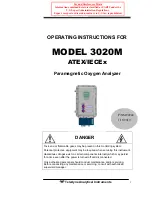
OPERATION
PRS-200 Series
7
If the effect of tens of microvolts are significant to
your application, connect to the instrument with low
thermal emf materials only. Copper wire and copper
alloys are recommended, whereas brass and steel
should be avoided. Tinned copper and solder is ac-
ceptable.
This emf will
not
be reflected if an AC measurement
instrument is employed, and can be eliminated by us-
ing a meter with “True Ohm” capability. In other
cases, the emf may represent a very small compo-
nent of a DC resistance measurement.
3.3 Dial Setting
Each decade is manually controlled via a front panel
thumbwheel that provides positions for “0” through
“9”. The total impedance is set / read from the dial
setting in a direct fashion. The decimal point, if any,
is marked on the thumbwheel switches, and the steps
are clearly marked on the panel. Short Circuit / Open
Circuit mode control is only available using a Remote
control option.
3.4 Environmental Conditions
The PRS is built, calibrated and intended for use in a
laboratory environment with a nominal ambient tem-
perature near 23
o
C. The accuracy of the unit may be
affected when operated in non-laboratory environ-
ments. Always allow the instrument to stabilize to room
temperature after unpacking or relocating the instru-
ment. Humidity should be maintained at laboratory
conditions.
3.5 Local Operation
Operation of the PRS-202 substituter is straightfor-
ward and graphically represented on the front panel.
1.
Turn on the
POWER
switch. The
POWER
indicator lamp, if present, should come on.
If a REMOTE option is present, the
READY
and
LOCAL
indicators should il-
luminate.
2.
Set the
REMOTE/LOCAL
switch to
LO-
CAL
.
3.
Connect any desired instrumentation to the
front panel binding posts. The
GND
termi-
nal may be connected to the ground of ex-
ternal equipment. The
GND
terminal is con-
nected to the case and to both chassis and
earth grounds.
4.
Make 4-terminal or 2-terminal connections
as described previously. A shielded set of
cables is recommended whenever AC op-
eration is involved.
5.
Set the thumbwheel switches to provide the
actual desired impedance in the actual units
indicated on the front panel.
3.6 Remote Operation
The PRS includes a
REMOTE/LOCAL
switch on
the front panel. The
REMOTE
position is a remote
enable
. When in
LOCAL
mode, the PRS supplies
the impedance value selected using the front panel
thumbwheel switches.
When the switch is in the
REMOTE
position, the
PRS will supply the configured remote impedance
value
only if
that option asserts remote control. If
the option does not assert control, the front panel thum-
bwheel impedance value is supplied. The
REMOTE
and
LOCAL LEDs
always indicate which interface
is controlling the impedance value.
Setting the front panel
REMOTE/LOCAL
switch
to LOCAL
overrides
the REMOTE option settings
and
always
sets the supplied impedance to the value
selected using the front panel thumbwheels, regard-
less of the REMOTE option’s assertion of control.
The REMOTE BCD option sets impedance values
and asserts control using TTL logic. The impedance
values are BCD encoded per table 4.2.
For IEEE and RS232 units, the
LOCAL
indicator
remains on until communication with the unit is initial-
ized. The mode changes to
REMOTE
after con-
troller commands are given.











































